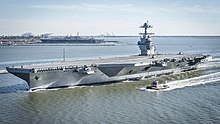
Back تاريخ بحرية الولايات المتحدة Arabic Geschichte der United States Navy German Yhdysvaltain laivaston historia Finnish Histoire de l'United States Navy French Історія військово-морських сил США Ukrainian


| This article is part of a series on the |
| History of the United States |
|---|
 |
| Ships of the United States Navy | |
|---|---|
 | |
| Ships in current service | |
| Ships grouped alphabetically | |
| Ships grouped by type | |
The history of the United States Navy divides into two major periods: the "Old Navy", a small but respected force of sailing ships that became notable for innovation in the use of ironclads during the American Civil War, and the "New Navy" the result of a modernization effort that began in the 1880s and made it the largest in the world by 1943.[1][2]
The United States Navy claims October 13, 1775 as the date of its official establishment, when the Second Continental Congress passed a resolution creating the Continental Navy. With the end of the American Revolutionary War, the Continental Navy was disbanded. Under the Presidency of George Washington, merchant shipping came under threat while in the Mediterranean by Barbary pirates from four North African States. This led to the Naval Act of 1794, which created a permanent standing U.S. Navy. The original six frigates were authorized as part of the Act. Over the next 20 years, the Navy fought the French Republic Navy in the Quasi-War (1798–99), Barbary states in the First and Second Barbary Wars, and the British in the War of 1812. After the War of 1812, the U.S. Navy was at peace until the Mexican–American War in 1846, and served to combat piracy in the Mediterranean and Caribbean seas, as well as fighting the slave trade off the coast of West Africa. In 1845, the Naval Academy was founded at old Fort Severn at Annapolis, Maryland by the Chesapeake Bay. In 1861, the American Civil War began and the U.S. Navy fought the small Confederate States Navy with both sailing ships and new revolutionary ironclad ships while forming a blockade that shut down the Confederacy's civilian coastal shipping. After the Civil War, most of its ships were laid up in reserve, and by 1878, the Navy was just 6,000 men.
In 1882, the U.S. Navy consisted of many outdated ship designs. Over the next decade, Congress approved building multiple modern steel-hulled armored cruisers and battleships, and by around the start of the 20th century had moved from twelfth place in 1870 to fifth place in terms of numbers of ships. Most sailors were foreigners. After winning two major battles during the 1898 Spanish–American War, the American Navy continued to build more ships, and by the end of World War I had more men and women in uniform than the British Royal Navy.[3] The Washington Naval Conference of 1921 recognized the Navy as equal in capital ship size to the Royal Navy, and during the 1920s and 1930s, the Navy built several aircraft carriers and battleships. The Navy was drawn into World War II after the Japanese Attack on Pearl Harbor on December 7, 1941, and over the next four years fought many historic battles including the Battle of the Coral Sea, the Battle of Midway, multiple naval battles during the Guadalcanal Campaign, and the largest naval battle in history, the Battle of Leyte Gulf. Much of the Navy's activity concerned the support of landings, not only with the "island-hopping" campaign in the Pacific, but also with the European landings. When the Japanese surrendered, a large flotilla entered Tokyo Bay to witness the formal ceremony conducted on the battleship Missouri, on which officials from the Japanese government signed the Japanese Instrument of Surrender. By the end of the war, the Navy had over 1,600 warships.
After World War II ended, the U.S. Navy entered the 45 year long Cold War and participated in the Korean and Vietnam proxy wars. Nuclear power and ballistic and guided missile technology led to new ship propulsion and weapon systems, which were used in the Nimitz-class aircraft carriers and Ohio-class submarines. By 1978, the number of ships had dwindled to less than 400, many of which were from World War II, which prompted Ronald Reagan to institute a program for a modern, 600-ship Navy. Following the 1990-91 collapse of the Soviet Union the Soviet Navy was divided among the former Soviet Republics and was left without funding, which made the United States the world's undisputed naval superpower, with the ability to engage and project power in two simultaneous limited wars along separate fronts. This ability was demonstrated during the First and Second Persian Gulf Wars.
In March 2007, the U.S. Navy reached its smallest fleet size, with 274 ships, since World War I. Former U.S. Navy admirals who head the U.S. Naval Institute have raised concerns about what they see as the ability to respond to 'aggressive moves by Iran and China.'[4][5] The United States Navy was overtaken by the Chinese People's Liberation Army Navy in terms of raw number of ships in 2020.[6]
- ^ Crocker III, H. W. (2006). Don't Tread on Me. New York: Crown Forum. p. 302. ISBN 978-1-4000-5363-6.
- ^ Frederick S. Harrod, Manning the New Navy: The Development of a Modern Naval Enlisted Force, 1899-1940 (Praeger, 1978).
- ^ Howarth 1999, p. 324
- ^ Stewart, Joshua (April 16, 2012). "SECNAV: Navy can meet mission with 300 ships". Navy Times. Retrieved November 7, 2012.
- ^ Freedberg, Sydney J. Jr. (May 21, 2012). "Navy Strains To Handle Both China And Iran At Once". Aol Defense. Archived from the original on October 15, 2012. Retrieved November 7, 2012.
- ^ "China's vast fleet is tipping the balance against U.S. In the Pacific". Reuters.